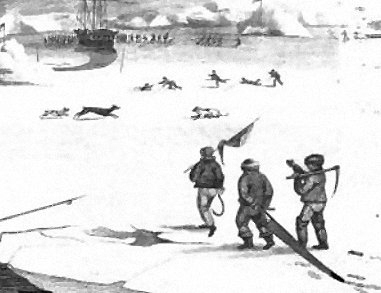[ William Edward Parry / Journal of a Second Voyage for the Discovery of a Northwest Passage from the Atlantic to the Pacific ]
The full title of this work is Journal of a Second Voyage for the Discovery of a Northwest Passage from the Atlantic to the Pacific; performed in the years 1821-22-23, in His Majesty's ships Fury and Hecla, under the orders of Captain William Edward Parry; it was first published in 1824 (London: John Murray), from which the text below is taken.
The first mention of the Newfoundland which accompanied the expedition occurs when the crew meet a group of "Esquimaux":
On our way the Esquimaux were much amused by our dogs, especially by a large one of the Newfoundland breed, that had been taught to fetch and carry — a qualification which seemed to excite unbounded astonishment; and the children could scarce contain themselves for joy, when Captain Lyon gave them a stick to throw for the dog to bring back to them. A child of five or six years old, thus amusing itself on such a day and in such a climate, formed by no means the least characteristic figure of our motley group. (159)
The second and final mention occurs on pages 381:
Some wolves continued still to prowl about us, and three of these hungry animals were nearly on the point of attacking a Newfoundland dog of Mr. Richard's, which went playing about them, when he was called off in time to save him.
Parry's account, like so many Victorian travel and exploration narratives, was illustrated. Below is part of an image entitled "Cutting Into Winter Island, October 1821." (One of the sailors in the foreground is dragging a large saw, of the sort used to cut channels through the ice, or to cut "docks" or clear spaces when the pressure of the ice threatened the hull of the ship.) In the middle ground are the three dogs which were brought along by members of the expedition. One, on the left, was a spaniel, here shown chasing the black greyhound which belonged to Commander Parry. The third dog, crouching on the snow watching the other two dogs, was the Newfoundland, and if this illustration is accurate, that Newf was what would later become known as a Landseer.
A review of this book appeared in the popular monthly Gentleman's Magazine (October 1823) and mentions that the native "Esquimaux" dogs "are fleecy full-grown animals, of the size and docility of the common Newfoundland breed, but with some of the appearances of the wolf species" (356). (I assume that even though Parry's book bore, on its title page, a publication date of 1824, it was in fact published a few months prior to January of 1824, a not-uncommon occurrence at the time.)
Capt. Parry undertook a third expedition in search of the Northwest Passage in 1824 - 1825, but makes no mention of any dogs at all in his account of that voyage (published 1826), nor in his account of his unsuccessful attempt to reach the North Pole (1826 - 1827).

